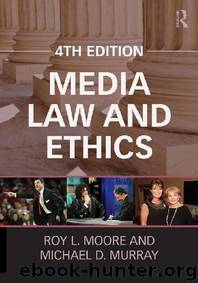Media Law and Ethics (Routledge Communication Series) by Roy L. Moore & Michael D. Murray & Michael Farrell & Kyu Ho Youm

Author:Roy L. Moore & Michael D. Murray & Michael Farrell & Kyu Ho Youm [Moore, Roy L.]
Language: eng
Format: epub
Publisher: Taylor and Francis
Published: 2012-03-27T05:00:00+00:00
The state supreme court felt that the jury could reasonably infer that the Post reporter held a grudge against the prosecutor because of the incident at the high school game and from a statement made by Salvato to Ball in a phone conversation, presumably implying a threat that Ball would be “hearing from” him. The court ruled there was evidence presented at trial that statements were false and defamatory, including the “they couldn’t have a better friend” comment from the former narcotics officer and claim he lost half the cases he took to trial. The court rejected the idea that some statements were opinions enjoying First Amendment protection. It noted the refusal to publish a retraction as evidence of actual malice.
The newspaper petitioned the U.S. Supreme Court to grant a writ of certiorari, but the Court turned it down, 6½ years after the series appeared. The newspaper’s insurance reportedly covered most legal fees, but the Post probably paid $50,000 to $100,000 as a deductible in the award to Ball plus a percentage (typically 20%) of the amount above the deductible.85 Reporter Al Salvato died in 2006 after a long and distinguished career in journalism.
E. W. Scripps et al. v. Ball is typical of libel suits the media face in four ways, although circumstances differ. First, the plaintiff was a public official and had to demonstrate with clear and convincing evidence or “convincing clarity” that the defendant published the story with actual malice, as required under New York Times v. Sullivan (1964). Public figures and public officials have a heavier evidentiary burden to meet in successfully suing for libel than private individuals, but they are more likely to sue. Three factors explain this. First, public officials and public figures get more media attention than private people. They are supposedly more newsworthy. Second, public officials and public figures usually have greater finances and can persevere more than private citizens who may not be able to afford court costs and attorney fees. Because they are in the limelight, public figures depend on positive reputations for a livelihood. When an image is hurt, damages mount.
A second way in which E. W. Scripps v. Ball typifies libel lies in how it meandered through the courts. While the trend appears to have reversed by now, plaintiffs in the past were more likely than defendants to win libel suits. More libel suits are settled out of court than ever reach trial or they are dismissed before trial. Many are settled with payment to plaintiffs. Media defendants cannot count juries among friends, as witnessed by major megabuck awards.
Third, the treatment accorded the Post in the courts reflects the trends in other courts. Whereas a lower appellate court may occasionally reverse a libel award, higher appellate courts, especially state supreme courts, are just as likely to uphold. State and federal appellate courts are following the lead of the U.S. Supreme Court. That is why state Supreme Court delayed its decision on the appeal until Harte-Hanks Communications v. Connaughton could be decided.
Download
This site does not store any files on its server. We only index and link to content provided by other sites. Please contact the content providers to delete copyright contents if any and email us, we'll remove relevant links or contents immediately.
Cecilia; Or, Memoirs of an Heiress — Volume 1 by Fanny Burney(31341)
Cecilia; Or, Memoirs of an Heiress — Volume 3 by Fanny Burney(30938)
Cecilia; Or, Memoirs of an Heiress — Volume 2 by Fanny Burney(30896)
The Lost Art of Listening by Michael P. Nichols(6480)
We Need to Talk by Celeste Headlee(4876)
Asking the Right Questions: A Guide to Critical Thinking by M. Neil Browne & Stuart M. Keeley(4589)
On Writing A Memoir of the Craft by Stephen King(4219)
Dialogue by Robert McKee(3587)
I Have Something to Say: Mastering the Art of Public Speaking in an Age of Disconnection by John Bowe(3518)
Pre-Suasion: A Revolutionary Way to Influence and Persuade by Robert Cialdini(3419)
Elements of Style 2017 by Richard De A'Morelli(2945)
The Book of Human Emotions by Tiffany Watt Smith(2775)
Good Humor, Bad Taste: A Sociology of the Joke by Kuipers Giselinde(2558)
Name Book, The: Over 10,000 Names--Their Meanings, Origins, and Spiritual Significance by Astoria Dorothy(2494)
Fluent Forever: How to Learn Any Language Fast and Never Forget It by Gabriel Wyner(2448)
The Grammaring Guide to English Grammar with Exercises by Péter Simon(2397)
Why I Write by George Orwell(2361)
The Art Of Deception by Kevin Mitnick(2300)
Don't Sleep, There Are Snakes by Daniel L. Everett(2220)
